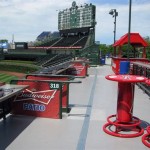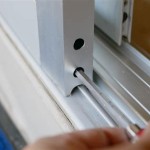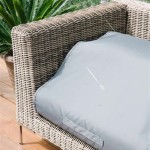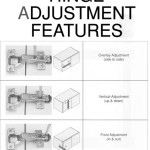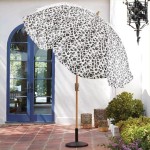Outdoor Stand Fans for Patio: Enhancing Comfort in Open-Air Spaces
Outdoor stand fans for patios represent a practical solution for improving comfort in outdoor living areas. These fans are designed to withstand the elements while providing a cooling breeze, making them a valuable addition to patios, decks, and other open-air spaces. The selection of an appropriate outdoor stand fan requires consideration of several factors, including durability, airflow capacity, and safety features.
The primary function of an outdoor stand fan is to circulate air, which reduces the perceived temperature and provides relief from heat and humidity. This is particularly beneficial in regions with warm climates, where outdoor activities can be significantly limited by uncomfortable weather conditions. By creating a gentle breeze, these fans help to evaporate moisture from the skin, resulting in a cooling effect that enhances the enjoyment of outdoor spaces.
The construction materials used in outdoor stand fans are crucial for ensuring their longevity and resistance to weather-related damage. These fans are typically constructed from durable materials such as powder-coated steel, aluminum, or weather-resistant plastics. These materials are designed to withstand exposure to sunlight, rain, and other environmental factors without corroding or deteriorating. The motor housing is typically sealed to protect the electrical components from moisture, further extending the lifespan of the fan.
Furthermore, outdoor stand fans are designed with safety features that minimize the risk of accidents. These features often include weighted bases or anchoring systems to prevent the fan from tipping over in windy conditions. The fan blades are typically made from lightweight materials and enclosed within a protective cage to prevent injury. Electrical components are also grounded and protected against short circuits to ensure safe operation.
The airflow capacity of an outdoor stand fan is a critical factor to consider when selecting a model. Measured in cubic feet per minute (CFM), airflow capacity indicates the volume of air that the fan can move. A higher CFM rating generally corresponds to a greater cooling effect. The appropriate CFM rating will depend on the size and layout of the patio area, as well as the user's preference for airflow intensity. Adjustable speed settings allow users to customize the airflow to their specific needs and comfort level.
In addition to their functional benefits, outdoor stand fans can also contribute to the aesthetic appeal of a patio. These fans are available in a variety of styles and finishes, allowing users to select a model that complements their existing outdoor décor. Some models feature decorative accents or integrated lighting, further enhancing their visual appeal. The overall design of the fan should be considered in relation to the overall style and atmosphere of the patio.
Key Points to Consider When Selecting an Outdoor Stand Fan
Durability and Weather Resistance
The most important aspect of selecting an outdoor stand fan is its ability to withstand the rigors of outdoor use. Exposure to the elements, including sunlight, rain, and wind, can quickly degrade inferior materials. Look for fans constructed from powder-coated steel, aluminum, or UV-resistant plastics. These materials are specifically designed to resist corrosion, fading, and other forms of weather-related damage. The motor should be enclosed in a waterproof or weather-resistant housing to protect the electrical components.
Examine the fan's construction for any signs of weakness or vulnerability. The base should be sturdy and stable, preferably weighted to prevent tipping. The fan blades should be made from a durable, yet lightweight material that will not crack or break under stress. The cage surrounding the blades should be strong enough to protect against accidental contact. Consider the warranty offered by the manufacturer, as this can provide an indication of the fan's overall quality and durability.
Furthermore, consider the climate in which the fan will be used. In areas with high humidity, corrosion resistance is particularly important. In areas with strong winds, a heavier base or anchoring system is essential. In areas with intense sunlight, UV-resistant materials are necessary to prevent fading and degradation. Selecting a fan that is specifically designed for the local climate will ensure its long-term performance and reliability.
The quality of the fasteners and hardware used in the fan's construction is also important. Look for stainless steel or other corrosion-resistant hardware that will not rust or weaken over time. Check the tightness of all screws and bolts before using the fan, and periodically inspect them for signs of loosening or corrosion. Proper maintenance will help to extend the lifespan of the fan and ensure its continued safe operation.
Airflow Capacity and Speed Settings
The airflow capacity of an outdoor stand fan is a crucial factor in determining its effectiveness in cooling a patio area. Airflow capacity is typically measured in cubic feet per minute (CFM), and a higher CFM rating indicates a greater volume of air movement. The appropriate CFM rating will depend on the size of the patio, the level of shade, and the desired level of cooling. For larger patios, a fan with a higher CFM rating will be necessary to provide adequate air circulation.
Consider the layout of the patio when determining the appropriate CFM rating. A patio with multiple seating areas may require multiple fans to provide adequate cooling in each area. A patio with obstructed airflow, such as one surrounded by walls or trees, may require a fan with a higher CFM rating to overcome the resistance to air movement. Experiment with different fan placements to find the optimal configuration for maximizing airflow throughout the patio.
Adjustable speed settings are also an important feature to consider. These settings allow users to customize the airflow to their specific needs and comfort level. Low speed settings are ideal for creating a gentle breeze on mild days, while high speed settings are useful for providing maximum cooling on hot days. The ability to adjust the airflow allows users to find the perfect balance between comfort and energy efficiency.
Some outdoor stand fans also feature oscillation, which further enhances their cooling effectiveness. Oscillation allows the fan to rotate from side to side, distributing airflow over a wider area. This can be particularly beneficial on larger patios, where a stationary fan may not provide adequate cooling to all areas. Consider a fan with adjustable oscillation angles to customize the coverage area.
Safety Features and Certifications
Safety is a paramount concern when selecting any electrical appliance, particularly one that will be used outdoors. Outdoor stand fans should be equipped with a range of safety features to minimize the risk of accidents and injuries. These features typically include a weighted base or anchoring system to prevent tipping, a protective cage surrounding the fan blades, and grounded electrical components.
A weighted base or anchoring system is essential for preventing the fan from tipping over, especially in windy conditions. Some fans feature a heavy, solid base, while others include stakes or screws that can be used to anchor the fan to the ground. Choose a fan with a base or anchoring system that is appropriate for the specific location and wind conditions. Always ensure that the fan is securely anchored before using it outdoors.
The protective cage surrounding the fan blades is designed to prevent accidental contact with the spinning blades. The cage should be made from a durable material that will withstand impact without breaking. The openings in the cage should be small enough to prevent fingers or other objects from coming into contact with the blades. Inspect the cage regularly for any signs of damage and replace it if necessary.
Grounded electrical components are essential for preventing electrical shock. The fan should have a three-prong plug that connects to a grounded outlet. Check the power cord for any signs of damage or wear and replace it if necessary. Do not use the fan with an extension cord unless it is specifically designed for outdoor use and is rated for the fan's power consumption. Always unplug the fan before cleaning or performing any maintenance.
Look for fans that have been certified by recognized safety organizations, such as UL, ETL, or CSA. These certifications indicate that the fan has been tested and meets established safety standards. Check the fan's label or packaging for these certifications before purchasing it. Following all safety precautions and guidelines will ensure the safe and enjoyable use of the outdoor stand fan.

18 Deco Adjustable Outdoor Standing Fan Breeze Dbf0622 Fans

Yokekon Oscillating Standing Fan Outdoor For Patios Floor With Rechargeable Battery Room Patio Camping Travel Brown

Newair 18 In 3 Speed Wide Angle Oscillating Outdoor Misting Fan And Pedestal For Cool Down 500 Sq Ft Black Fmf2k5bk00 The Home

Pineapple Outdoor Fan Frontgate

Kingston Outdoor Fan Frontgate

Holmes 16 Outdoor Misting Stand Fan 3 Speed Oscillating Gfci Hose Black

Holmes Outdoor 16 In Oscillating Misting Stand Fan Black 3 Speed With Adjustable Height And Gfci Plug 12096

The Torrento Outdoor Fan

Homepointe 16 Inch 3 Speed Tilt Head Oscillating Pedestal Stand Fan Black

Pineapple Outdoor Fan Frontgate

